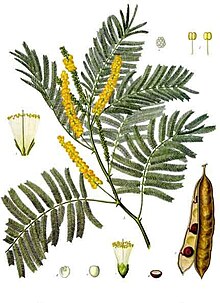Gerber acacia
| Gerber acacia | ||||||||||||
|---|---|---|---|---|---|---|---|---|---|---|---|---|

Gerber acacia ( Senegalia catechu ) |
||||||||||||
| Systematics | ||||||||||||
|
||||||||||||
| Scientific name | ||||||||||||
| Senegalia catechu | ||||||||||||
| ( Lf ) PJHHurter & Mabb. |
The gerber acacia ( Senegalia catechu (L. f.) PJHHurter & Mabb., Syn .: Acacia catechu (L. f.) Willd. , Acacia wallichiana DC., Mimosa catechu L. f.), Sometimes also catechu acacia or only catechu called, is a in South and Southeast Asia -based species of the genus of Acacia ( Acacia ).
description
Vegetative characteristics
The gerber acacia is a deciduous tree that reaches heights of between 6 and 10 meters. The bark is brittle and tears into flat strips. The twigs have a downy, hairy bark and often have a few hook-shaped thorns below the stipules .
For example, in northern India, the leaves fall around February and are devoid of leaves during the hot season; new leaves are formed towards the end of April or May. The leaves are divided into a petiole and a leaf blade. The base of the petiole are glands. In the double-pinnate leaf blade sit on the shaggy hairy leaf spindle (rachis) 10 to 30 pairs of first-order pinnate with 20 to 50 leaflets each. The ciliate leaflets are linear with a length of 2 to 6 millimeters and a width of 1 to 1.5 millimeters.
Generative characteristics
In each of the leaf axils there are one to four 2.5 to 10 centimeter long spiked inflorescences. The hermaphrodite flowers are yellow to white with a double flower envelope . The calyx is bell-shaped and 1.2 to 1.5 centimeters in size. The calyx teeth are deltoid and hairy. The sparsely downy hairy petals are lanceolate or inverted-lanceolate with a length of about 2.5 centimeters. The stamens are numerous. The ovary measures about 1 millimeter and is glandular.
The fruit stalks are 3 to 7 millimeters long. The shiny brown legumes are belt-shaped and relatively flat with a length of 12 to 15 centimeters and a width of 1 to 1.8 centimeters. The fruits tear open after the fruit ripens and contain three and ten seeds . In China, the fruits ripen between September and the following January.
The number of chromosomes is 2n = 26.
distribution
Natural occurrences are found in the Yunnan Province in the People's Republic of China , in Bangladesh , Bhutan , India , Myanmar , Nepal , Pakistan , Sri Lanka and Thailand . Since the species is in culture, there are also neophytic occurrences, for example on Java .
use
The seeds contain a water-soluble, high-protein mucus that can be consumed by humans. The leaves are considered good feed and are mainly fed to goats. The wood is good firewood that is also charred . The wood is also well suited as construction timber.
A tannin-containing resin obtained from hardwood, called catechu or cutch , is used in tannery and dyeing . Gum arabic can be extracted from the bark .
Crystalline catechu, called Cutch, which is then called Khersal , is used in the medical treatment of sore throats .
The active ingredient of gerber acacia is said to be a strong astringent that helps with chronic diarrhea , dysentery and colitis as well as leucorrhea and can be used as a mouthwash for stomatitis ( inflammation of the oral mucosa ), gingivitis (inflammation of the gums ), pharyngitis (inflammation of the throat ) and laryngitis (inflammation of the larynx ) can be used. To do this, the heartwood should be dried.
literature
- Delin Wu & Ivan C. Nielsen: Acacieae , p. 55 - the same text online as the printed work : Acacia catechu , p. 57 , In: Wu Zheng-yi, Peter H. Raven & Deyuan Hong (eds.): Flora of China , Volume 10 - Fabaceae , Science Press and Missouri Botanical Garden Press, Beijing and St. Louis, 2010. ISBN 978-1-930723-91-7
Web links
- Acacia catechu. In: AgroForestryTree Database. Archived from the original on October 23, 2013 ; Retrieved August 29, 2013 .
Individual evidence
- ↑ David Hoffmann : Naturally healthy - herbal medicine . Over 200 herbs and medicinal plants and their effects on health. Ed .: Element Books . 1st edition. Element Books, Shaftesbury , England , UK 1996, Part Three: The Plant Directory, pp. 53 (256 pp., English: The Complete Illustrated Holistic Herbal . Shaftesbury, England 1996. Translated by Mosaik Verlag).




